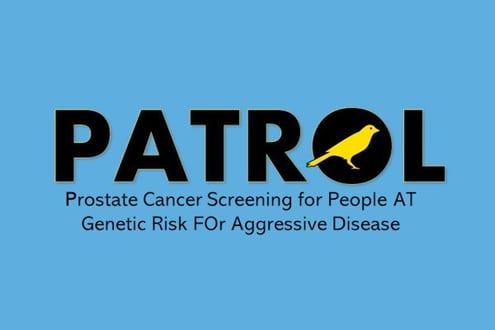Prostate Cancer: Screening Guidelines
Cancer Screening Guidelines
Note that when we use the terms "male" and "men" we are referring to people assigned male at birth. This section covers the following topics:
cancer screening for high-risk people
The National Comprehensive Cancer Network (NCCN) has guidelines for screening using tests and digital rectal exam (DRE) in people age 40 and older who are at increased risk for cancer.
- If you have a mutation, NCCN recommends yearly screening.
- NCCN recommends other high-risk people should consider annual screening after having a conversation with their doctor about the benefits and risks of testing. This includes people who:
- have a mutation in another gene linked to cancer
- have a family history of cancer
- are Black/African American
- High-risk people should consider enrolling in a screening clinical trial.
See the table below for more details.
Gene or Risk Level |
Beginning Age |
Recommendation |
40 |
Recommend annual digital rectal exam and Prostate Specific Antigen (PSA) test. |
|
40 |
Have a conversation with your doctor about your risk for aggressive prostate cancer and the benefits and risks of screening. Consider digital rectal exam and PSA testing every 1-2 years depending on prior screening results. |
|
|
40 |
Have a conversation with your doctor about your risk for aggressive prostate cancer and the benefits and risks of screening. Consider digital rectal exam and PSA testing every 1-2 years depending on prior screening results. |
Source: NCCN Guidelines: Genetic/Familial High-Risk Assessment: Breast, Ovarian, Pancreatic, Prostate, vs. 2, 2025; Source: NCCN Guidelines: Prostate Cancer Early Detection, vs. 2, 2024. |
||
Screening for average-risk people
There are several different guidelines for cancer screening in people of average risk. All of the guidelines include having a conversaton with your doctor about your risk for cancer and the benefits, risks and limitations of screening using PSE testing and DRE. The recommended frequency of screening depends on whether the results are low or slightly elevated. See the table below for more details.
- NCCN recommendations begin at age 45.
- The U.S. Preventive Services Task Force () recommendations begin at age 55.
- The American Cancer Society (ACS) recommendations begin at age 50.
Guideline |
Beginning Age |
Recommendation |
National |
45 |
Have a conversation with your doctor about the benefits and risks of screening. Consider screening with Prostate Specific Antigen (PSA) test and digital rectal exam (DRE). If you choose to have screening:
|
The U.S. Preventive Services Task Force (USPSTF) |
55 until age 70 |
Have a conversation with your doctor about the benefits and risks of screening in order to decide what is right for you.
|
American Cancer Society |
50 |
Have a conversation with your doctor about the benefits and risks of screening in order to decide what is right for you. If you choose to have screening:
|
Source: NCCN Guidelines: Genetic/Familial High-Risk Assessment: Breast, Ovarian, Pancreatic, Prostate, vs. 2, 2025; Source: NCCN Guidelines: Prostate Cancer Early Detection, vs. 2, 2024; American Cancer Society Recommendations for Prostate Cancer Early Detection. |
||
Below are some of our featured research studies looking at new treatments for cancer treatment. To search for more studies, visit our Search and Enroll Tool.

PATROL Study: Prostate Cancer Screening for People AT Genetic Risk FOr Aggressive Disease
Clinicaltrials.gov identifier: NCT04472338

Screening Study for Men at High Genetic Risk for Prostate Cancer
Clinicaltrials.gov identifier: NCT03805919

Screening in Men at High Risk of Developing Prostate Cancer
Clinicaltrials.gov identifier: NCT05608694

Prostate Cancer Genetic Risk Evaluation and Screening Study (PROGRESS)
Clinicaltrials.gov identifier: NCT05129605

Upright MRI for Prostate Cancer Screening
Clinicaltrials.gov identifier: NCT03474913

Study for People with Unexpected Genetic Results
Clinicaltrials.gov identifier: NCT02595957